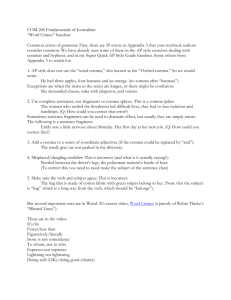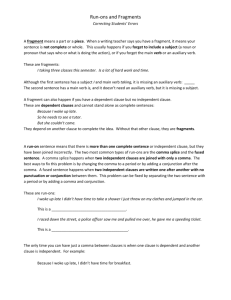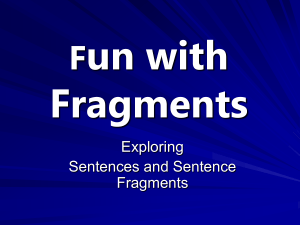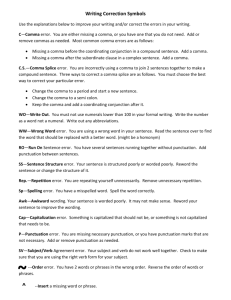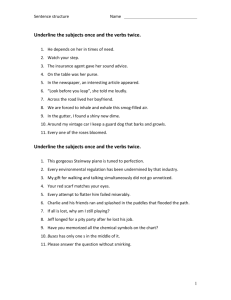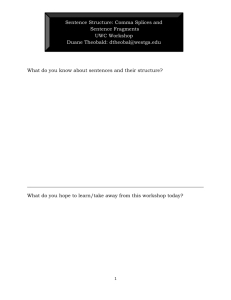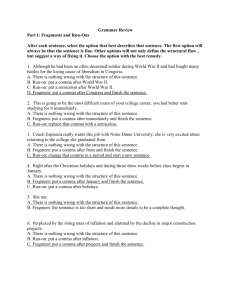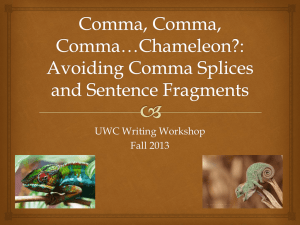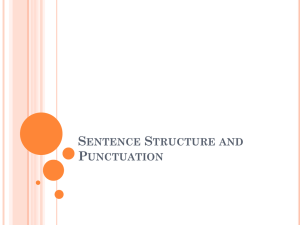Fragments - Valencia College
advertisement
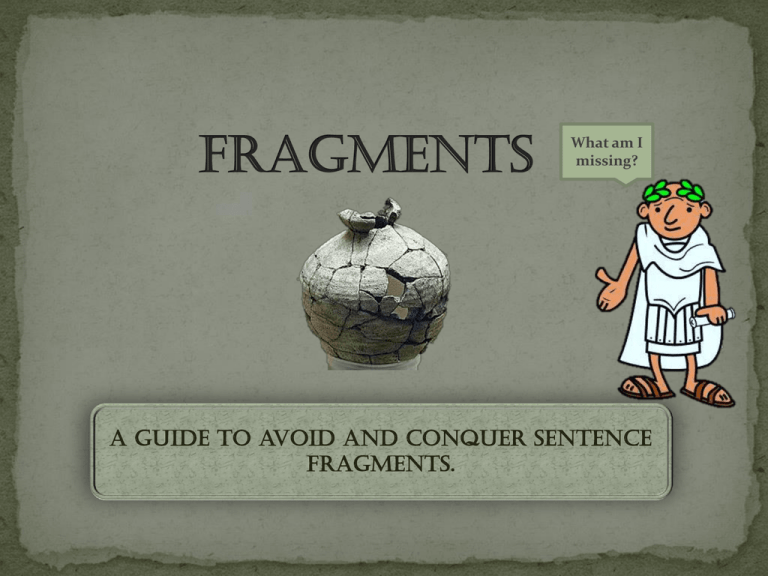
What am I missing? A guide to avoid and conquer sentence fragments. A sentence fragment is a word group that lacks a subject or a verb and fails to express a complete thought. How do I fix this? Verb Complete Thought Dependent- word fragment II. -ing and To fragments III. Added-detail fragment IV. Missing-subject fragment I. What is a dependentword fragment? Some sentences that begin with dependent words (like the words listed to the right) can create fragments. Dependent Words List After When, Whenever Although Where, Wherever As Whether Because Which, Whichever Before While Even though Who, Whom, Whose How If, even if In order that Since That, so that Unless Until What, Whatever Examples of how dependent words can create a fragment: 1. After I cashed my paycheck. 2. Although I was nervous. 3. If I don’t get a raise soon. 4. When the sun came out. 5. Since I love cats. What are these sentences called? Dependent sentences because they have to rely on another sentence to become grammatically correct. What do they need? To be attached to an independent sentence with a comma What’s that again? An independent sentence contains a subject, a verb, and expresses a completed thought. Let’s learn how to fix these sentences on the next slide! 1. After I cashed my paycheck. 2. Although I was nervous. 3. If I don’t get a raise soon. 4. When the sun came out. 5. Since I love cats. With a comma, attach an independent sentence onto the dependent sentence. For example: 1. After I cashed my paycheck, I paid my bills. 2. Although I was nervous, I gave a great speech. 3. If I don’t get a raise soon, I will quit. 4. When the sun came out, the flowers started to bloom. 5. Since I love cats, I adopted three of them. Notice: The subject is in bold, the verb is italicized, and the complete thought is underlined. Note: We attached the dependent sentence to the independent sentence with a COMMA. 1. Cate walked all over her neighborhood yesterday. Trying to find her cat Bobo. Several people claimed they had seen him only hours before. 2. At the Chinese restaurant, Fred used chopsticks. To impress his date. He spent one hour eating a small bowl of rice. Cate walked all over her neighborhood yesterday, trying to find her cat Bobo. Several people claimed they had seen him only hours before. Explanation Here, we attached the first independent sentence starting with the subject, Cate, and attached it to the dependent sentence starting with the word, trying, with a comma and took out the period and lowercased the t. We placed a comma before the word, trying, because that word is not a proper subject, so that sentence cannot stand on its own. It has to depend on the first independent sentence because it contains a subject, a verb, and a complete thought to be grammatically correct. 1. At the Chinese restaurant, Fred used chopsticks. To impress his date, he spent one hour eating a small bowl of rice. Explanation For this sentence, we took away the period after the word, date, and we replaced it with a comma because starting a sentence with the word, to, automatically makes it a dependent clause, so the sentence needs to rely on the independent sentence starting with the subject, he. 2. An added-detail fragment usually lacks a subject and a verb and often begins with one of the signals words below: Examples: 1. Phillip works at a movie theatre. He enjoys the fringe benefits. Like seeing the new movies first. 2. Amber loves watching daytime television shows. Especially old movies and soap operas. Corrected Examples: 1. Phillip works at a movie theatre. He enjoys the fringe benefits like seeing the new movies first. 2. Amber loves watching daytime television shows, especially old movies and soap operas. Explanation: 1. For #1, we attached the second sentence to the first and did not add a comma because there does not need to be a comma before the preposition like. 2. For #2, we attached the second sentence to the first and added a comma before especially. Note: especially is one of the words in the list in slide #10. • A missing-subject fragment is exactly what it sounds like. It’s a sentence that is missing a subject, so it cannot be an independent sentence. Remember, the subject is a noun(s) that grounds the sentence. It’s who or what the sentence is about. Where is the subject? 1. Christine loved getting wedding presents. But hated writing thank-you notes. 2. Many people are allergic to seafood. They break out in hives when they eat it. And can even have trouble breathing properly. 1. Christine loved getting wedding presents but hated writing thank-you notes. Explanation: For #1, we took out the period before the word, but, and lowercased the b. We did this because in the first sentence we have a proper subject, Christine, but in the second sentence, we do not have a subject, so that sentence cannot stand alone unless we added the word, she, in it. 2. Many people are allergic to seafood. They break out in hives when they eat it, and they can even have trouble breathing properly. Explanation: For #2, we added a comma before the coordinating conjunction, and, and then we added the subject, they. Adding a comma before the coordinating conjunction and adding the subject, they, makes this an independent sentence. Break Down: You can either attach the part of the sentence that is missing a subject to a sentence that has a subject, or you can simply add a subject to form an independent sentence. Remember, the key to conquering sentence fragments is to always make sure that your sentences contain a subject, a verb, and express a complete thought. Most of the information in this PowerPoint is from John Langan’s book, College Writing Skills with Readings, Eighth Edition. For extra help on fragments: Go to: http://owl.english.purdue.edu/owl/resource/620/1/ Stop by our center for more tip sheets, worksheets, and computer exercises, located on the Winter Park Campus in room 136!
